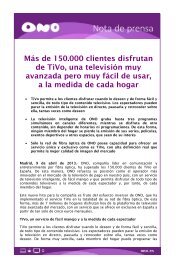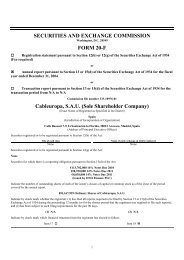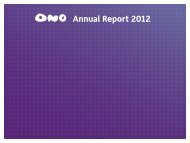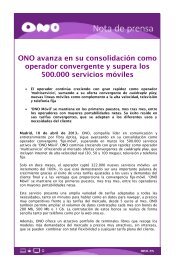Supplemental Disclosure Material - Ono
Supplemental Disclosure Material - Ono
Supplemental Disclosure Material - Ono
Create successful ePaper yourself
Turn your PDF publications into a flip-book with our unique Google optimized e-Paper software.
(4) “RGUs” are revenue generating units where each customer is counted as a revenue generating unit for each service for which such<br />
customer subscribes, regardless of the number of services that customer receives from us. Thus a single customer who receives internet,<br />
television and telephony services from us would account for three RGUs.<br />
(5) “Net churn” means the percentage obtained by dividing the number of customers who cease to receive any of our services (either<br />
voluntarily or involuntarily) in the last quarter of the relevant period by the average total number of customers during that quarter,<br />
multiplied by four. The average number of customers for any period is calculated by adding the number of customers at the beginning of<br />
the period to the number of customers at the end of the period and dividing by two. Excluded from net churn are customers who move<br />
locations and terminate their subscription at their old location but resubscribe at their new location.<br />
(6) We do not report numbers of customers in the “large accounts & corporations” and “wholesale & other” business segments because such<br />
data are not meaningful.<br />
(7) Audited.<br />
The following are key factors affecting our results during the periods under review:<br />
Transformation Process<br />
Towards the end of 2008, faced with weakening international economic conditions, we commenced a<br />
transformation process. The transformation focused on adjusting our business model to the changed economic environment<br />
and stabilizing its operations following a period of rapid expansion, with the aim of creating a more efficient platform for<br />
future growth. This process also coincided with significant changes in our senior management. Largely completed by the end<br />
of 2009, the transformation process included a wide range of initiatives focused on maximizing cash flow, implementing cost<br />
efficiencies, reshaping our organization and attracting and retaining high-quality customers. As a result of the transformation,<br />
we believe we have become a more resilient and efficient company. Our EBITDA increased from €730 million in 2009 to<br />
€748 million in 2011, our EBITDA margin increased from 48.3% in 2009 to 50.4% in 2011 and operating free cash flow<br />
decreased from €510 million in 2009 to €456 million in 2011.<br />
Customer Focus and Effects of Recession<br />
As part of our transformation process, we developed and began to implement a new strategy focused on the<br />
acquisition and retention of high-quality customers and on product superiority (including our high-speed internet packages<br />
and our next generation TV service—TiVo). Previously our focus had been on customer acquisition, which included the use<br />
of short-term promotions and mass market advertising, resulted in relatively high levels of net churn at the end of the<br />
promotion period. Our new strategy involves focusing our marketing and customer care efforts on attracting and retaining<br />
more creditworthy customers whom we judge less likely to churn and to whom we believe we can successfully market our<br />
double- and triple-play bundled packages. We believe that the success of this new strategy is reflected in our improved ARPU<br />
and RGU numbers during 2009, 2010 and 2011 in the residential and SME segments.<br />
However, the economic recession in Spain that resulted from the financial and economic crisis started in 2008 has<br />
significantly impacted our financial and operational performance, partially offsetting the effect of our revised customer focus<br />
strategy in the periods under review. In this sense, although certain operational metrics have improved during the periods<br />
under review, largely as a result of our new strategy and despite the adverse economic climate, our revenues were essentially<br />
unchanged between 2009 and 2010. Revenues recorded positive growth in 2011 and increased by 0.9% as compared to 2010.<br />
The combined effect of our new customer strategy and the impact of the adverse economic climate in Spain on our<br />
residential fiber customer numbers, net churn, ARPU and RGUs is described below:<br />
Residential fiber customers: Our residential fiber customer base decreased by 0.8% in 2010, by 0.2% in 2011 and<br />
by 1.7% in the twelve months ended March 31, 2012, to reach approximately 1.8 million customers. The slight decline in our<br />
residential fiber customer numbers between 2009 and 2011 was primarily driven by the shift in our focus to more<br />
creditworthy customers through the introduction of a credit scoring system, additional activation and installation fees and<br />
reductions in promotions, as well as by the challenging economic and industry environments in Spain. The decrease<br />
experienced in the twelve months ended March 31, 2012 was primarily driven by the slowdown in the number of broadband<br />
additions experienced in the market coupled with the new dynamics experienced in the Spanish telecom market by which<br />
most operators shifted from aggressive customer acquisition strategies to strategies focused on customer retention.<br />
Residential fiber net churn: Our net churn (based on the last quarter of each period) for our residential fiber<br />
business increased from 13.9% in 2009 to 18.8% in 2011. This increase was primarily driven by some customers dropping<br />
their telecommunication services to preserve their disposable incomes, along with the increased promotional activity<br />
experienced in the Spanish telecommunication market that has impacted a portion of our most price sensitive customers<br />
(mainly single play customers). In the quarter ended March 31, 2012, our residential fiber net churn increased by 3.6% as<br />
compared to the same quarter of the previous year to reach 18.4%. This increase was primarily driven by some customers<br />
dropping their telecommunication services to preserve their disposable incomes, along with the increased promotional activity<br />
experienced in the market that impacted a portion of our most price sensitive customers (mainly single play customers). Going<br />
forward we intend to continue focusing on stabilizing net churn with the implementation of a series of initiatives to promote<br />
22

















